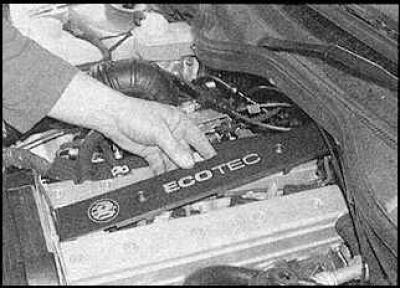Spark plug
Correct operation of spark plugs is very important for the efficient operation of the engine.
Replacement

1. Unscrew the mounting screws and remove the cover from the valve cover. Disconnect the cables and hoses that prevent access to the spark plugs.


2. Mark the high voltage wires and disconnect them using the special tool (indicated by an arrow), if it is needed.
3. Clean the area around the spark plugs and remove the spark plugs.
4. The condition of the spark plugs can provide valuable information about the condition of the engine.
5. If the spark plug tip is clean and white with no deposits, the fuel mixture is too lean.
6. If the tip of the spark plug is covered with black deposits, then the fuel mixture is too saturated.
7. If the tip of the spark plug is covered with light brown or gray deposits, then the fuel mixture is adjusted correctly and the engine is most likely in good condition.

8. The spark gap of multi-electrode spark plugs cannot be adjusted.


9. Measure the spark plug gap with a feeler gauge (drawing on the right) or special tool (drawing on the left).

10. Adjust the spark gap by bending the tip.
11. Reinstall the spark plugs. To make installing spark plugs easier, fit a short piece of tubing over the spark plug. It will act as a universal joint and will not allow damage to the threads.

12. Tighten the spark plugs to the correct torque and connect the wires. Reinstall the cover.
Fuel filter - replacement
On all models, the fuel filter is located near the fuel tank.
1. Release pressure from the supply system.
2. Raise the rear of the vehicle and place it on stands.


3. Release the mounting clip, disconnect the fuel pipes and remove the filter.

4. Install a new filter. When installing, check that the arrow (1) pointed in the direction of fuel flow. Check that the fasteners are installed correctly (2).
Timing belt - replacement
See subsection 3.3.7 and subsection 3.2.7.

Visitor comments